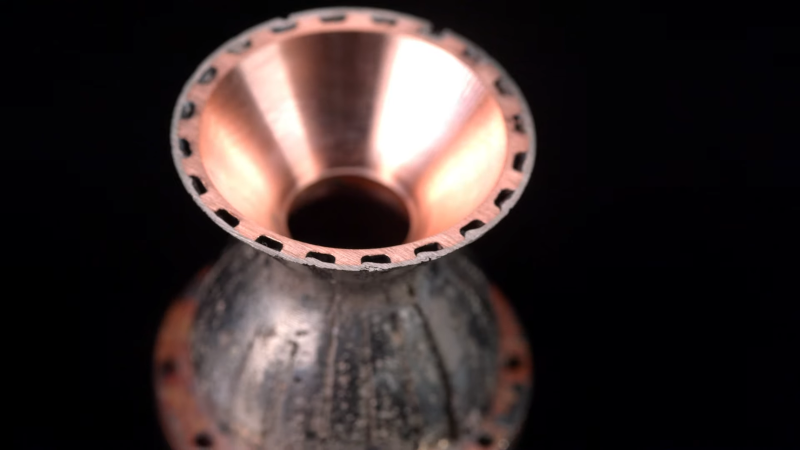If we asked you to design a circuit to blink a flashing turn signal, you would probably reach for a cheap micro or a 555. But old cars used bimetallic strips in a thermomechanical design. Why? Because, initially, 555s and microcontrollers weren’t available. [Breaking Taps] has the story of NASA engineers who needed some special cooling chambers in a rocket design for the Space Shuttle. Today you’d 3D print them, but in the 70s, that wasn’t an option. So they used wax. You can see a video about the process, including a build of a model rocket engine, in the video below.
The issue is the creation of tiny cooling channels in the combustion chamber. You can use additional thin pipes brazed onto the engine. However, there are several disadvantages to doing this way, but early rocket engines did it anyway. Having the cooling path integrated into the system would be ideal, but without 3D printing, it seems difficult to do. But not impossible.
The technique uses wax and machined slots that will eventually become the tubes required. Then you electroplate material on top of the wax to form the outer shell of the tube. In fact, NASA used two electroplating steps: a thin copper layer to close the tube and a thicker nickel layer to provide strength. Copper survives contact with the cryogenic coolant better than nickel does, but nickel is much stronger, so the combination makes sense. Because electroplating needs a conductive surface, the wax needs some help. NASA used a fine silver powder coating, but [Breaking Taps] simply impregnated the wax with graphite. Clearing the wax out afterward is a bit challenging but doable.
If you think about it, electroplating might be one of the original additive manufacturing techniques. In fact, people have made printers based on the idea, but they are very slow. On the other hand, electroplating a plastic print takes less time and looks great, even if you wouldn’t use it for a rocket engine.
















Regarding the video, cool, very cool on so many levels. Very well explained too.
Regarding “might be one of the original additive manufacturing techniques”. How about knitting, like in knitting a sweater, isn’t that an additive manufacturing technique too. My good old granny, used a spool of wire (wool to be precise) and with a special tool (which were basically two thin sticks, which she guarded with her life) she used the material from the spool of wire into amazing products. She made, socks, hats, sweaters, scarfs, mittens and even swimming gear, although my mother mentioned that wasn’t a huge success. My grandfather and his grandfather made wicker woven baskets with his bare hands, although I believe he used a knife too, but that was a trade secret as he never mentioned that.
Additive manufacturing exists in many forms and places, you only need to be willing to look. In nature, bees assemble the most creative structures, wasp and termites too. You might even consider that additive construction methods proceed all other construction technologies but I have to admit, it would be a little far fetched. Regarding far fetched… nehh never mind.
Pottery, rammed earth, mudbrick houses, any biscuit extruded or iced through a nozzle..
Concrete in a form…
Cast iron…
you could include everyone on the planet in the list of things created by additive manufacturing,its a bit slow
as the print averages 1lb/month
We’ve got all the stuff at hand to accellerate that “print speed” hahahah
I don’t know maybe I’m wrong but additive construction seems to be adding more substance to an object to make a larger object, like the people below mention, pottery, concrete, cast iron, while things like knitting seem to me to be more of a construction technique, you take one thing and through manipulation turn it into a wanted form through mechanical connections. I know it’s just a niggle but making a brick and making a wicker basket just seem to be different forms of production to me.
You might be right. Weaving is not fusing the material together.
Also, if we’re going into details, the word “printing” implies a particular process. It implies something impressed with a print or formed in a mold, so the act of “3D printing” is a misnomer. It is not achieved through the application of any sort of stamp or a mold. In fact, a regular 2D inkjet printer is not printing either – it is painting. A laser printer is a true printer, since it produces a stamp onto its transfer roller and presses it onto the paper with heat.
It could be said bees are the oldest 3d printers with all their little multi axis printing heads and insane resolution.
Same as the cooling channels in turbine blades, https://www.theengineer.co.uk/content/in-depth/jewel-in-the-crown-rolls-royce-s-single-crystal-turbine-blade-casting-foundry/
Others as well.
https://youtu.be/1qifd3yn9S0
Interesting comments as IMO 3d printing is another whole additive manufacturing subcategory in regards that it can metaphorically be used in all other cases some how or another, and also being the new “modern” regular mental reference when someone says”additive manufacturing “. All in all I love 3d printing and the endlessnes of the possibilities.
It’s actually one of the oldest kinds of additive manufacturing.
https://en.wikipedia.org/wiki/Coiling_(pottery)
PIC > 555